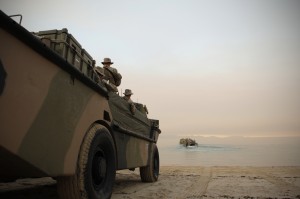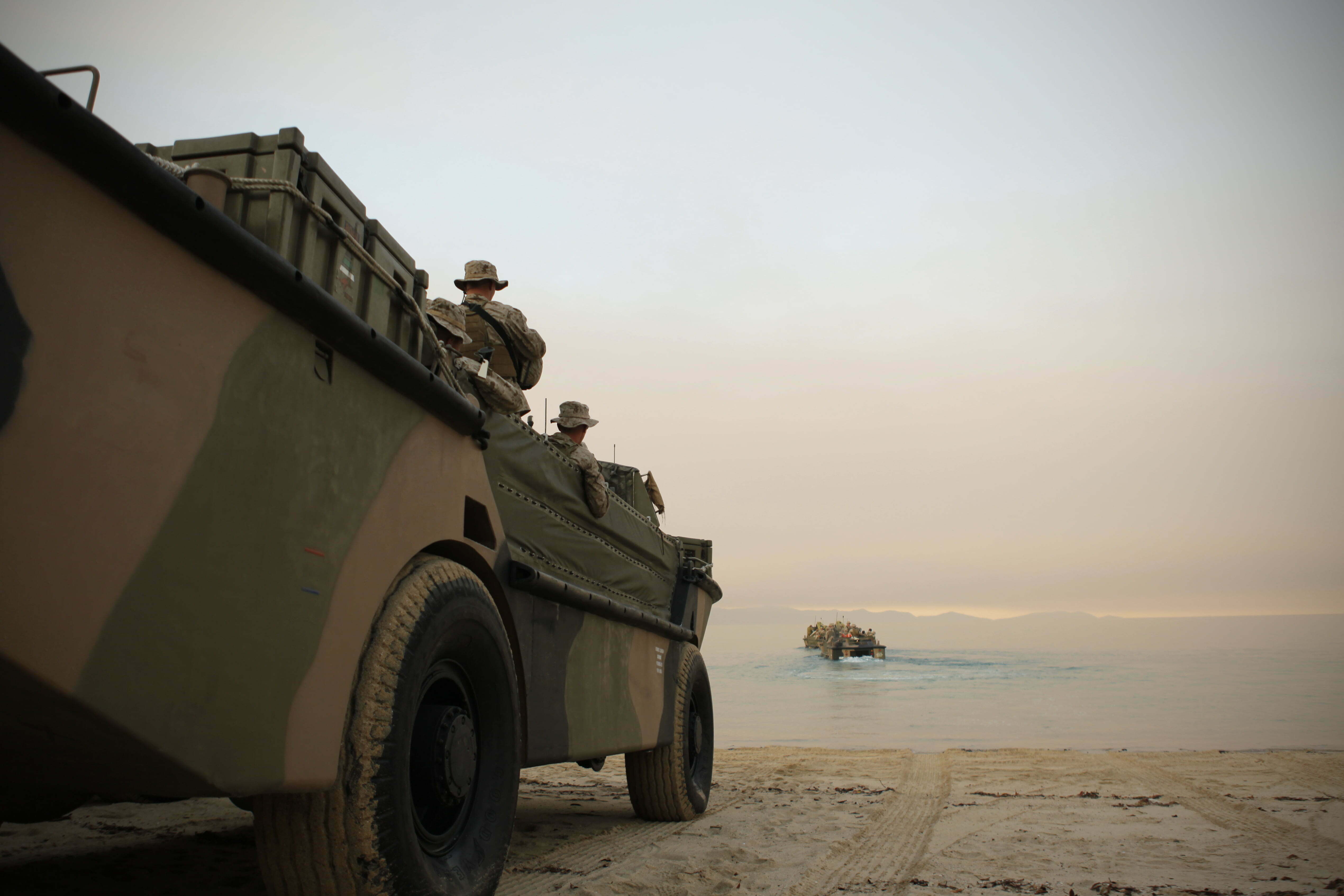In a follow up interview with Lt. General Robling, MARFORPAC, the challenges of executing the Pivot to the Pacific were discussed.
In the earlier interview, Lt. General Robling underscored the centrality of persistent presence as a core element of shaping an effective strategy and capability for the US in the Pacific.
The USMC is a key element of the US Pivot to the Pacific. The USMC is really at the center of the pivot to the Pacific.

The USMC is not only redeploying in the region but enhancing its role as a rotational force as well.
As Col. John Merna, the Commanding Officer of the 31st MEU put it in a recent interview:
In one sense, the Marines are going back to the force levels we had in the region prior to 9/11. So it is simply a restoration rather than a build up or build out.
But the way the force is being configured is very different. We are emphasizing building out a rotational force, notably in Australia, but elsewhere as well.
The USMC is itself “pivoting” in the Pivot to the Pacific. USMC forces in Okinawa are moving partly to Guam and the Marines are shaping a new working relationship with the Australians in Western Australia.
In fact, they are the lead force in re-shaping the U.S. presence in the Pacific over the next few years.
SLD: With the budgetary challenges, what are some of the biggest potential hurdles to effectively rebalancing the force to the Pacific from the USMC perspective in the Pacific?
Lt. General Robling: A major element for us in rebalancing is getting the 10th ARG shaped for deployment out of San Diego.
We are looking for this ARG to be a key anchor in the area, and notably to work with the Australians. In addition to that, additional strategic lift of all types (C-17 aircraft, JHSV’s, TAKE’s or MLPs, super ferries, etc) will be required to move forces around this expansive AOR which comprises over 52% of the earth’s surface.
(For the significance of Australia in reforming force structure in the Pacific see the following:
The CNO and the Commandant have recently underscored in a joint article the importance of amphibious ships and theater lift like JHSV vessels and we need the assets they emphasized. They are crucial to the persistent presence, which I discussed earlier.
The region is clearly strategically significant. To operate we need to have the range, speed and lift necessary to be effective. Nonetheless, the Air Force trying to get rid of some of their C-17s, and the Navy is trying to reduce amphibious lift to pay for other ships and it’s going to be difficult if such cuts happen.
This means as well that innovation needs to be rewarded and encouraged.
We might even think about augmenting the types of platforms, which could allow us to do effective innovation.
For example, the T-AKE ships are proving to be very effective and very versatile. Unlike some ships, the T-AKE can operate with the Osprey on board. And as such, we could provide ways to better use elements of the amphibious force. Currently we keep the USS Bonhomme Richard (LHD-6) in ready reserve for HA/DR or emergency extractions. We could do the same mission with a T-AKE ship if we had enough of them.
SLD: Recently we looked at the kind of reform the Australian Army is undergoing with changes associated with amphibious lift and other approaches to greater mobility. How important is the USN-USMC team to the kind of land power reforms going on in the region?
Lt. General Robling: All of our forces are important to the security of this region, but I believe the USN-USMC team is strategically more important than any of the others.
While seven of the 10 largest land armies in the world reside in the Pacific region, many of those Armies are now concentrating on their territorial boarders. Many of their territorial defense lines are bordered on oceans or sea lanes. This requires them to have a capability to police their boarders in the littorals and they are looking to the USN-USMC to help them to either fill in capability gaps or train and equip to do this on their own successfully.
SLD: And the kind of transformation that the USMC has underway can meet needs effectively in the region as well. For example, how does the Osprey play into the transformation approach?
Lt. General Robling: Speed, range and presence are crucial to the kind of operations we participate in throughout the Pacific.
The Osprey clearly fits perfectly into the types of missions we are tasked to perform.
To illustrate hypothetically, if we were tasked to counter challenges in the South China sea, such as to bolster defense of Ayungin Shoal, also known internationally as Second Thomas Reef with one of treaty allies, the Philippines, the US has several options, but not all are efficient or even timely. We could use USAF assets, such as a B-2 bombers or B-52 aircraft from Guam, or Navy surface or subsurface assets that are patrolling in the South China Sea, but the location of those assets may not provide timely arrival on station.
But using the Osprey, we can fly down quickly from Okinawa with a platoon of well-trained Marines or SOF forces, land on difficult terrain or shipping, and perform whatever tasked that may be required in not only a timely but efficient manner.
SLD: There is the potential intersection among some key trends. The need for persistent presence and scalable forces can be facilitated by the new systems already in the Pacific, the Osprey, and the new ones on the way, the F-35B and the USS America, to name two. Allies are spending money and reshaping their approach to the configuration and operation of their forces, and are working with you in many ways to do so.
This means that instead of taking a penny wise and pound foolish approach towards investing in new systems and divesting old ones, if the we took a bold step forward to commit to the new systems, we might well see greater investments in some of these systems in the Pacific as well.
Lt. General Robling: This is not a good time to be penny wise and pound foolish, as you put it.
The Osprey’s capabilities are certainly driving interest in that platform’s capability. In addition, due to the innovative ways we use it, interest in other US technologies are also being looked at closely by our partners and close allies.
I certainly see a market for US technologies in the Pacific region for many years.
I believe this because our allies and others look at what we can do with the Osprey and are impressed. We do not have the strategic lift required to move all my forces around the AOR. Until I can get them, I am required to use C-17s that are very expensive and committed elsewhere or amphibious shipping that there is not enough of, or I contract black bottom shipping, the cost of which as nearly triple in the last five years.
To compensate, I can use KC-130 aircraft or V-22’s and move small numbers of lethal Marines thousands of miles. Is this efficient? No! Is this effective? Yes!
Nobody else has the capability afforded by the V-22 except our USAF SOF forces.
SLD: Let us go back to the Australian example of Army reform. What role does working with the USMC play in this reform?
Lt. General Robling: The Australians have very well trained and lethal forces. They can and want to play a bigger role in the collective security of the Pacific. One way they can do this is to take a portion of their very capable army and train them to do amphibious operations. Their Navy is already buying the amphibious ships required.
So they asked us to help them with the training and doctrine required to train up those forces.
Once they do, they can project their forces away from Australia and play a major role in filling in security gaps or by complimenting already forward deployed partner nations throughout the Pacific.
I would also mention Japan as well. They have a three ship flotilla participating in Exercise Dawn Blitz off the west coast of California. They are keenly interested in building their amphibious capability to complement their own significant capabilities for territorial defense. They asked us to help them in the same way we are helping the Australians.
Their training is progressing very well and their participation in this multi-nation exercise will be a big step in furthering their capabilities in amphibious operations.
I see this as the future of land power in the Pacific.
And working through the air-maritime-ground approach is central to this future.
Recently, I was speaking with General Hawk Carlisle, Commander of PACAF, about the F-35 and the capabilities it will bring to the kind of future operations we will do in the Pacific.
We both believe getting that capability out here sooner than later is extremely important.
He underscored how important it was for the forces of the future in the Pacific to be able to talk to one another and in a dense EW environment. The F-35 can do this and compliment other technologies in a way that may transform the way we deploy and fight. He agrees that the F-35 will be a centerpiece in such an effort, due to the aircraft MADL capabilities and ability to link with other platforms and help transmit it’s fused information.
I see the need for us to procure and train with additional complimentary air-maritime links which can talk to the F-35 in this environment.
Clearly the F-35 will be a game changer in our capabilities in the Pacific.
SLD: The USMC is focused on shaping a distributed operations force. For such a force, strike is built into the force but is not the defining quality. For many, augmenting the precision strike force is the key area for investments for the US in the Pacific. But the priority ought to be on building up the capabilities for distributed operations within which precision strike is embedded.
Notably, Admiral Moran recently characterized the new Ford Class carrier in these terms, yet many still seem caught in the precision strike first focal point.
Lt. General Robling: This is really an important point and important perspective. The key is persistent presence and a scalable force.
We need to be engaged in the process of reforming our various Pacific partners as well. We cannot nor should not do it all on our own.
A distributed force allows for the kind of security engagement we require to “fight tonight” or respond to further escalation if required.
Distributed operations and disaggregation is a fact of life in the Pacific.
There are 36 countries in this AOR and rarely do we send an ARG/MEU out where at some point in their patrol they are not required to disaggregate, do distributed operations for several countries, and then re-aggregate to form the entire force.
This is important. We have shown in both Exercise Bold Alligator and the work-up to Dawn Blitz that you can either break away one or two ships in your formation and increase the effects you can deliver to a coastline a thousand miles in each direction.
In many cases we don’t even need an amphibious ship. We can put a V-22 on a TAK-E that has 140 Marines aboard and extend the operating area an additional 500 miles in any direction they ship can operate.
Again, no one else has this capability except the USN-USMC team.
Also see the following:
The article by Lt. General Robling which can be found here:
http://www.sldforum.com/2013/06/the-usmc-and-pacific-operations/
And our recent piece on Asian land reforms:
https://sldinfo.com/dawn-blitz-bold-alligator-and-asian-army-reforms/
And our special report on Bold Alligator 2013:
https://sldinfo.com/bold-alligator-2013-shaping-a-21st-century-insertion-force/


